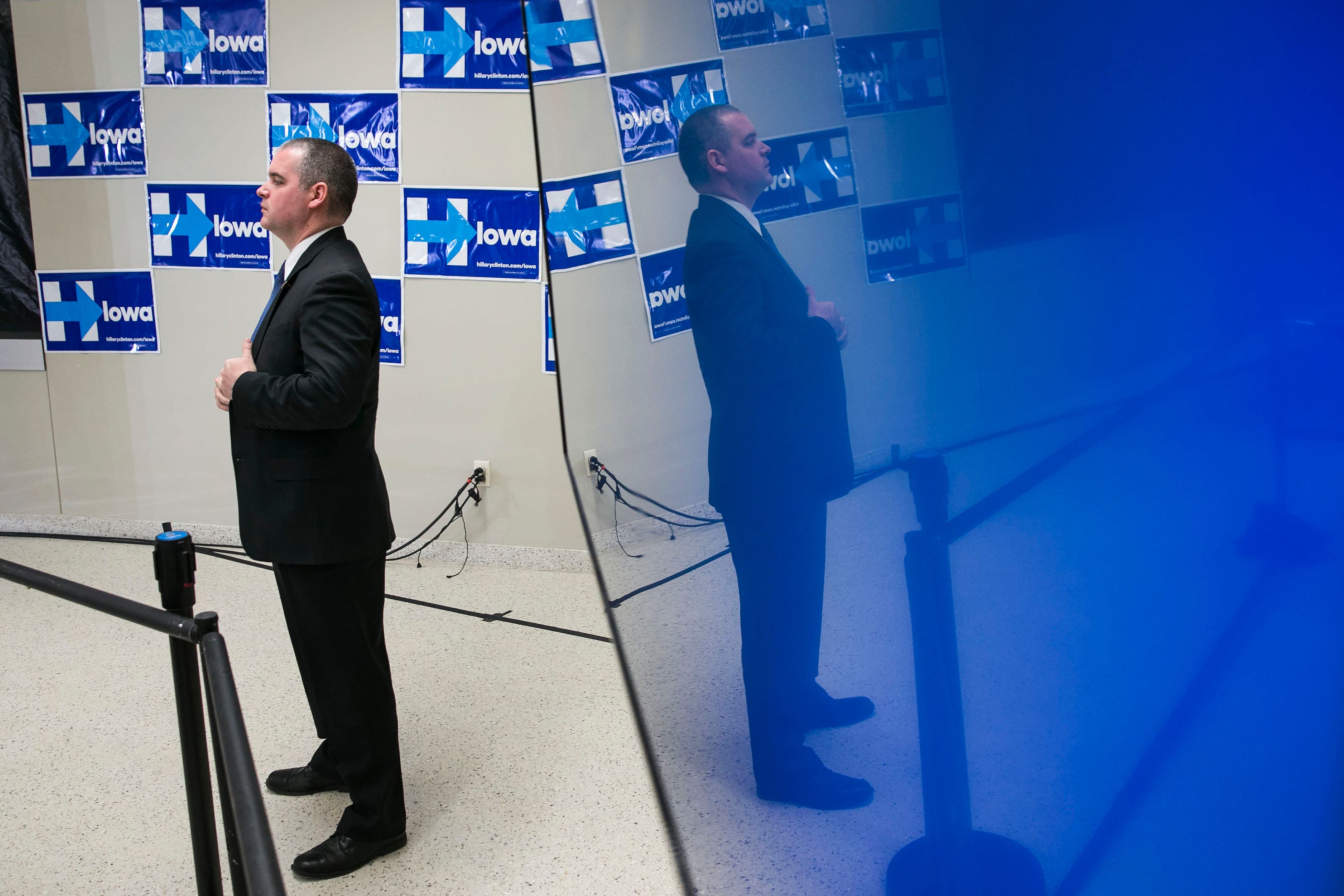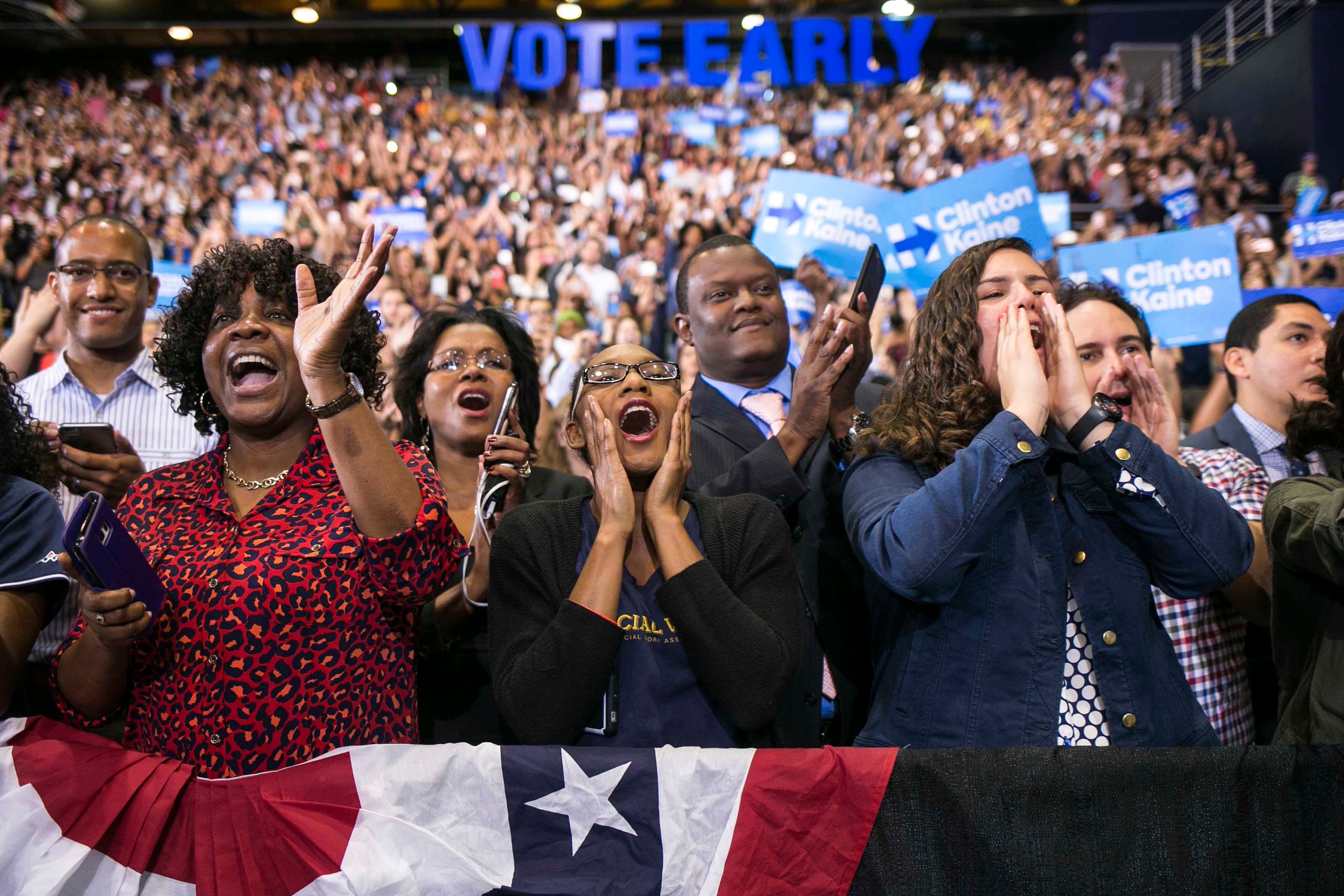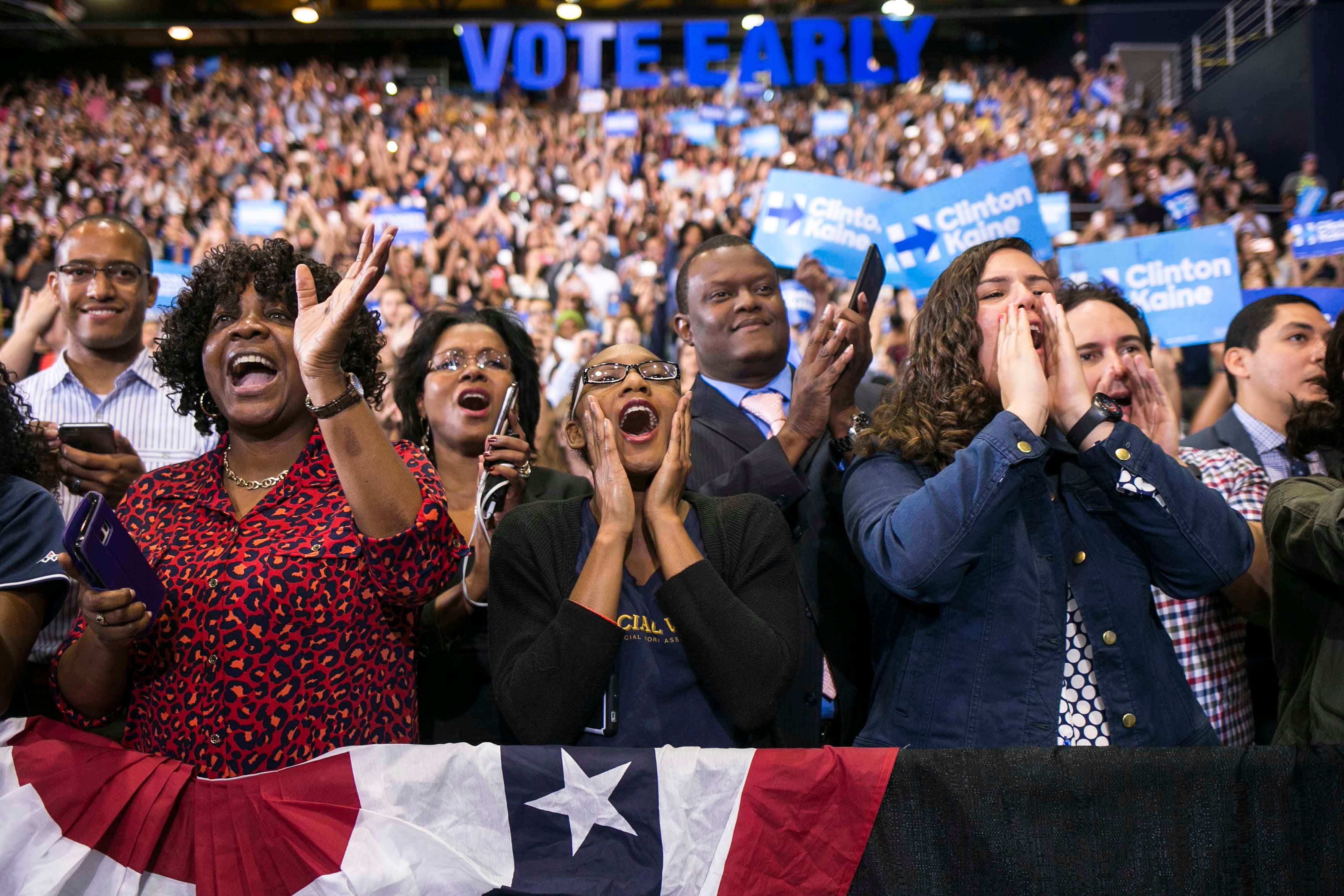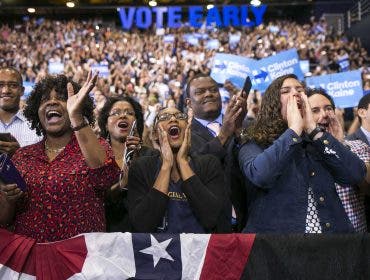
President Barack Obama speaks at a Hillary for America campaign event at the University of Central Florida, Friday, Oct. 28, 2016 in Orlando, Fla. (Al Drago/The New York Times)

Robyn Sanders, of Cary, N.C., wipes away a tear as she listens with her sister, Ashlyn, as President Barack Obama speaks at a campaign event for Democratic presidential candidate Hillary Clinton, as he promotes early voting, at the University of North Carolina at Chapel Hill, in Chapel Hill, N.C., Wednesday, Nov. 2, 2016. (Al Drago/The New York Times)

A protestor interrupts President Barack Obama as he speaks during a campaign event for Hillary Clinton at Fayetteville State University, in Fayetteville, N.C., Friday, Nov. 4, 2016. (Al Drago/The New York Times)

Al Drago Snapchats President Obama in Oct. 2015 in Cleveland Mich. Photo by jim watson/AFP

UNITED STATES - August 17: Republican presidential candidate Sen. Marco Rubio, R-Fla., speaks during a Family Night event at Dean Park, as seen from behind an American flag, in Ankeny, Iowa, Monday, August 17, 2015. (Photo By Al Drago/CQ Roll Call)

UNITED STATES - JANUARY 27 - In this long exposure photo, a giant poster of Republican presidential candidate Donald Trump stands on display in supporter George Davey's backyard in West Des Moines, Iowa, Wednesday, Jan. 27, 2016. (Photo By Al Drago/CQ Roll Call)

UNITED STATES - JANUARY 24 - A U.S. Secret Service agent stands watch before Democratic presidential candidate Hillary Rodham Clinton speaks at a Get Out the Caucus event with Sen. Cory Booker, D-N.J., at Vernon Middle School, in Marion, Iowa, Sunday, Jan. 24, 2016. (Photo By Al Drago/CQ Roll Call)

UNITED STATES - JANUARY 18 - A wax statue of John Wayne watches as Republican presidential candidate Donald Trump speaks during a news conference at the John Wayne Museum, Tuesday, Jan. 19, 2016, in Winterset, Iowa. (Photo By Al Drago/CQ Roll Call)

UNITED STATES - JANUARY 15 - Workers carry out a campaign sign for democratic presidential candidate Hillary Rodham Clinton, after a campaign event in Marshalltown, Iowa, on Friday, Jan. 15, 2016. (Photo By Al Drago/CQ Roll Call)

UNITED STATES - JANUARY 15 - Former President Bill Clinton reaches for a young boys hand that called out to him after a campaign event as he helps promote his wife, democratic presidential candidate Hillary Rodham Clinton, in Marshalltown, Iowa, on Friday, Jan. 15, 2016. (Photo By Al Drago/CQ Roll Call)

Attendees cheer as President Barack Obama speaks at a campaign event for Hillary Clinton at Florida International University, in Miami, Fla., Thursday, Nov. 3, 2016. (Al Drago/The New York Times)

Democratic presidential candidate Hillary Clinton speaks to the African Methodist Episcopal Church, also known as the AME Church, attendees during the 50th Quadrennial Session of the General Conference at the Philadelphia Convention Center in Philadelphia, Pa., Friday, July 8, 2016. (Al Drago/The New York Times)

UNITED STATES - APRIL 18 - Protestors are removed by law enforcement and security as Republican presidential candidate Donald Trump speaks at a campaign rally at the First Niagara Center, in Buffalo, N.Y., Monday, April 19, 2016. Trump has focused his campaign on the New York Primary, which is Tuesday, April 19, 2016. (Photo By Al Drago/CQ Roll Call)

President Barack Obama speaks at a Hillary for America campaign event at the University of Central Florida, Friday, Oct. 28, 2016 in Orlando, Fla. (Al Drago/The New York Times)

Robyn Sanders, of Cary, N.C., wipes away a tear as she listens with her sister, Ashlyn, as President Barack Obama speaks at a campaign event for Democratic presidential candidate Hillary Clinton, as he promotes early voting, at the University of North Carolina at Chapel Hill, in Chapel Hill, N.C., Wednesday, Nov. 2, 2016. (Al Drago/The New York Times)

A protestor interrupts President Barack Obama as he speaks during a campaign event for Hillary Clinton at Fayetteville State University, in Fayetteville, N.C., Friday, Nov. 4, 2016. (Al Drago/The New York Times)

Al Drago Snapchats President Obama in Oct. 2015 in Cleveland Mich. Photo by jim watson/AFP

UNITED STATES - August 17: Republican presidential candidate Sen. Marco Rubio, R-Fla., speaks during a Family Night event at Dean Park, as seen from behind an American flag, in Ankeny, Iowa, Monday, August 17, 2015. (Photo By Al Drago/CQ Roll Call)

UNITED STATES - JANUARY 27 - In this long exposure photo, a giant poster of Republican presidential candidate Donald Trump stands on display in supporter George Davey's backyard in West Des Moines, Iowa, Wednesday, Jan. 27, 2016. (Photo By Al Drago/CQ Roll Call)

UNITED STATES - JANUARY 24 - A U.S. Secret Service agent stands watch before Democratic presidential candidate Hillary Rodham Clinton speaks at a Get Out the Caucus event with Sen. Cory Booker, D-N.J., at Vernon Middle School, in Marion, Iowa, Sunday, Jan. 24, 2016. (Photo By Al Drago/CQ Roll Call)

UNITED STATES - JANUARY 18 - A wax statue of John Wayne watches as Republican presidential candidate Donald Trump speaks during a news conference at the John Wayne Museum, Tuesday, Jan. 19, 2016, in Winterset, Iowa. (Photo By Al Drago/CQ Roll Call)

UNITED STATES - JANUARY 15 - Workers carry out a campaign sign for democratic presidential candidate Hillary Rodham Clinton, after a campaign event in Marshalltown, Iowa, on Friday, Jan. 15, 2016. (Photo By Al Drago/CQ Roll Call)

UNITED STATES - JANUARY 15 - Former President Bill Clinton reaches for a young boys hand that called out to him after a campaign event as he helps promote his wife, democratic presidential candidate Hillary Rodham Clinton, in Marshalltown, Iowa, on Friday, Jan. 15, 2016. (Photo By Al Drago/CQ Roll Call)

Attendees cheer as President Barack Obama speaks at a campaign event for Hillary Clinton at Florida International University, in Miami, Fla., Thursday, Nov. 3, 2016. (Al Drago/The New York Times)

Democratic presidential candidate Hillary Clinton speaks to the African Methodist Episcopal Church, also known as the AME Church, attendees during the 50th Quadrennial Session of the General Conference at the Philadelphia Convention Center in Philadelphia, Pa., Friday, July 8, 2016. (Al Drago/The New York Times)

UNITED STATES - APRIL 18 - Protestors are removed by law enforcement and security as Republican presidential candidate Donald Trump speaks at a campaign rally at the First Niagara Center, in Buffalo, N.Y., Monday, April 19, 2016. Trump has focused his campaign on the New York Primary, which is Tuesday, April 19, 2016. (Photo By Al Drago/CQ Roll Call)
I remember early in the summer of 2015 when I was in the newsroom at Roll Call watching CNN and saw that another Republican was announcing his candidacy for president. Little did I know another five or six people after him would follow suit and it was just the early days of a long and strange campaign season.
My first true taste of the campaign was in August 2015 when I spent a week at the Iowa State Fair, following candidates meeting real people in unscripted moments, usually holding some kind of fried food. Although some candidates generated buzz and excitement, even back then there was nothing compared when Donald Trump and Hillary Clinton paid their visits.
I spent the fall covering mostly local appearances as candidates returned to Washington for work or fundraisers, before the race ramped up in 2016. The morning after the State of the Union in January, I returned to Iowa and spent the next three weeks covering the first in the nation Caucus. With so many candidates in the race, there were at least four to fives events that you could cover each day.
It was still early on in the election that access was not a problem and some of the campaign stops were unique, like Sen. Rand Paul in a barber shop and Donald Trump at the John Wayne museum.
There was a special bond with all the journalists in Iowa, everyone was in high spirits and we were all shivering together. Since this was the first election that I really covered all the way through, I’m especially grateful for all the fellow photographers that helped me out, from Doug Mills and Steve Crowley of the NYT, to Andrew Harnik of AP, Jabin Botsford of The Washington Post, and of course freelancers Eric Thayer and Aaron Bernstein.
Whether it was celebrating my birthday at an arcade bar in Des Moines, deciding to spontaneously stay overnight in Canada (Niagara Falls with WaPo’s Jabin Botsford), or dancing to the same seven rally songs on loop while waiting for a candidate running “just a few minutes behind schedule,” it’s really important to appreciate and support your coworkers.
While at Roll Call, unfortunately there were multiple occasions when I was denied access to Trump events or not allowed into the buffer with other photographers. Even though I was working for a respected newspaper, the campaign was only accommodating to a few select national media outlets. All the journalists were stuck in a pen at the back of the room, forced to only have one angle to cover Donald Trump.
Since moving to the Times in June, I have been covering President Obama’s final days in office. With regards to the campaign, I’ve been focusing on the angle of how the sitting President campaigns as one of Hillary Clinton’s strongest surrogates.
In terms of gear, I usually use two or three bodies, typically two Canon 1DX’s and a 5D Mark III. I try and stick with prime lenses and one zoom – 24mm f/1.4, 35mm f/2, 50mm f/1.2, 135mm f/2, 70-200mm f/2.8, and a 300mm f/2.8. I have my card reader and mifi internet attached to the back of my laptop so I can edit and transmit photos on the go quickly. I usually rock my Think Tank belt to hold a wide lens and my iPhone, and then carry my gear in my Think Tank Shape Shifter backpack. I tend to travel light so I can have all my gear in my backpack and clothes in a small roller that fits in overhead bins.
A few things I never leave the house without: Cigarette lighter to DC/USB power plug (for working on the road), gaff tape (to mark spots on risers), power bars, Mophie iPhone charging case and an external power brick (Snapchat and Instagram drain phone batteries), and of course I keep a tie and a rain jacket in my bag.



















